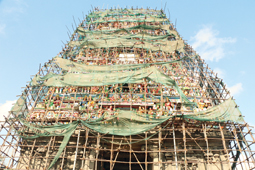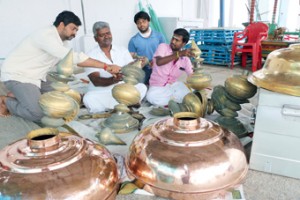Registered with the Registrar of Newspapers for India under R.N.I 53640/91
Vol. XXVI No. 02, May 1-15, 2016
The Sthapathi speaks…
Kapaliswarar temple restoration
 Gopuram renovation underway.
Gopuram renovation underway.
C.T. Manickam led his team of artisans to get the Sri Kapali Temple renovated and bright in time for the kumbhabhishekam. Here is the story of how the work was executed.
The last of the rituals and procession of the Panguni festival gets underway at Sri Kapali Temple. And in the Thursday darkness, the eastern gopuram of the temple remains enclosed in flimsy covers.
When the sun comes out and the covers flip-flop in the breeze, you get a peek at the wonderfully painted figurines on the same gopuram.
A gopuram that holds many little stories of the epics and also reflects daily life of another time..
You get to see all this only if you have the time to stop and stare, closely. Renovating temple gopuram‑s and vimana-s calls for expertise, patience and challenges.
C.T. Manickam Sthapathi, the person in charge of the repair and renovation of Sri Kapali Temple, is a man of few words.
“The December deluge in the city badly affected the pace of the work. But the focus was kept.
“The rajagopuram is 117 ft and 7 stories tall. We had to start the repair process from the top and work our way to the bottom,” he said.
Raising the massive scaffolding took time – 20 days. Once that served as the base for the workers to access the gopuram, they undertook the water wash and cleaning.
That work took the group about 20 days.


C.T. Manickam and his team at work on and off the temple.
Say Manickam, “Lots of figurines needed attention. Some were broken or cracked. So we used a water-based white primer on these figurines and this had to be done one floor at a time. After the primer, we started adding the colours. Once we were finished with one floor, we had to clean the next floor again before applying the primer.
The other gopuram-s were also renovated in the same way”.
“So what were the tough jobs up there?
Manickam said that Sri Kapali Temple had been well-maintained.
“Work was executed for the kumbabhishekam in 2004 and again in 2008 when lightning struck (the gopuram) and so we didn’t have too much to do. Only a few figurines on the other gopuram-s needed repairs… small things, to their arms, legs and body parts.
“We use a mixture of lime (chunnam) and sand to repair cracks,” says Manickam.
Though the work called for calculated and steady execution, there were big challenges.
“Working on the gopuram-s was not easy,” said this senior sthapathi who is from Karaikudi and has been in this profession for more than 40 years.
“There are always risks associated with work done on a tall structure. To prevent accidents, we make sure that the scaffolding is erected properly with sufficient space for the workers to move around.”
And then, his men had to deal with the large number of bird’s nests with eggs (in them) which they moved to other safer locations.
Over 30 artisans from Karaikudi and Mayavaram worked for the past many months on the temple’s gopuram-s, vimanam-s and shrines.
The kumbabhishekam took place on April 3rd. (Courtesy: Mylapore Times)
Preeti Srivatsan

